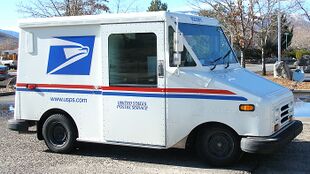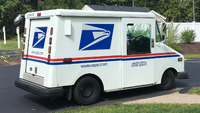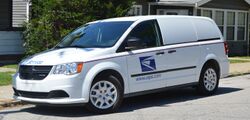Engineering:Grumman LLV
| Grumman Long Life Vehicle | |
|---|---|
 A 1989 Grumman LLV of the United States Postal Service, seen in Carson City, Nevada, in December 2005. | |
| Overview | |
| Manufacturer | Grumman |
| Also called | USPS Mail truck, Grumman Mailcat |
| Production | 1987–1994[1] |
| Assembly | Montgomery, Pennsylvania |
| Body and chassis | |
| Class | Mail truck |
| Related | KurbWatt, Kubvan |
| Powertrain | |
| Engine |
|
| Transmission | 3-speed GM TH180 automatic[2] |
| Suspension | |
| Front | 54.1 in (1,374 mm)[3] |
| Rear | 63 in (1,600 mm)[3] |
| Dimensions | |
| Length | 175.5 in (4,458 mm)[3] |
| Width | 75 in (1,905 mm)[3] |
| Height | 85 in (2,159 mm)[3] |
| us|uk|Kerb|Curb}} weight | 2,700 lb (1,225 kg) |
| Chronology | |
| Predecessor | Jeep Dispatcher |
| Successor | |
The Grumman Long Life Vehicle (LLV) is an American light transport truck model, designed as a mail truck for the United States Postal Service, which has been its primary user since it first entered service in 1987, 37 years ago. It also was used by Canada Post. The LLV uses a chassis built by GM based on the S-10 with an aluminum body built by Grumman.
In 2021, after a long competition, the USPS announced it had awarded a $6 billion contract to Oshkosh Defense to produce the Next Generation Delivery Vehicle, which will replace the LLV. In February 2023, the USPS announced the purchase of 9,250 each of stock Ford E-Transit vans and Stellantis gasoline-powered vans.[4] (As of May 2023), the first custom NGDVs were scheduled to enter service in June 2024, nine months after the original October 2023 target date.[5]
History
In the United States of America , the Grumman LLV is the most common vehicle used by letter carriers for curbside and residential delivery of mail, replacing the previous standard letter-carrier vehicle, the Jeep DJ-5. Curbside delivery from a driver seated in a vehicle to a curbside mailbox is sometimes termed "mounted delivery", in contrast to walking delivery.[6]
The Grumman LLV was the first vehicle specifically designed for the United States Postal Service (USPS); the USPS provided a specification and three teams created prototypes that were tested in Laredo, Texas in 1985: Grumman in partnership with General Motors, Poveco (a joint venture of Fruehauf and General Automotive Corporation), and American Motors Corporation.[7] The main design points of the vehicle in contract competition were serviceability, handling in confined areas, and overall economical operation. Prototypes were each subjected to a 24,000 mi (39,000 km) road test, including frequent starts and stops, gravel surfaces, cobblestones and potholes, hauling a payload of up to 2,000 lb (910 kg).[7]
Previously, Grumman had built a limited number of KurbWatts, a battery electric vehicle with an aluminum delivery van body, which was tested by the USPS in the early 1980s.[8] At about the same time, Grumman also built 500 KubVans, which used a similar lightweight aluminum delivery body on a Volkswagen Pickup diesel chassis and also underwent testing by the USPS. These designs influenced Grumman's candidate body design for the LLV.[9] Grumman won the competition and was awarded a $1.1 billion contract to produce 99,150 LLVs in April 1986;[10] USPS also held an option for an additional 54,000 LLVs.[11]
Production
The vehicles were assembled by the Allied Division of Grumman in Clinton Township in Lycoming County, Pennsylvania. The first vehicle was completed in April 1987. At peak production, 95 LLVs were completed each day, at a rate of approximately one every 5 minutes.[11] Grumman invested $28 million into the factory, doubling its size to 213,000 sq ft (19,800 m2) and increasing the workforce from 250 to 600.[11]
The USPS purchased more than 100,000 of these vehicles, the last one in 1994.[1] As its name suggests, the Grumman LLV is easily capable of a long life. The required lifespan specified by the U.S. Postal Service was 24 years, but in 2009 this was extended to 30 years. The Grumman LLV can easily last over 200,000 miles on its original engine and transmission before needing an overhaul.[12][13]

The USPS acquired 21,000 Ford-Utilimaster FFVs in 2000 and 2001 to supplement the LLV fleet. The FFVs have a similar aluminum body and also are right-hand drive, but ride on a chassis built by Ford Motor Company with a body built by Utilimaster.[14]:12
In 2010, approximately 140,000 LLVs remained in the USPS delivery fleet;[15][14]:12 retirement and attrition had reduced that to 126,000 by 2021.[16]:Table 4-6.13 A number were also sold to Canada, Mexico, and several other countries.[citation needed]
Technical
Like the older postal-service Jeep DJ-5, the Grumman LLV features a right-hand drive (RHD) configuration, in contrast to the typical left-hand drive (LHD) position of vehicles in North America. It also features a large metal tray, which is able to hold three trays of letter mail, mounted where a passenger seat would normally be. This arrangement positions the driver on the side of the vehicle closest to the curb, enabling the carrier to easily grab sorted mail and place it into mailboxes without having to leave the seat. Other notable features are an exceptionally tight turning radius[7] and a low-geared, 3 speed transmission[2] for hauling heavy cargo. The LLV has a 1,000-pound (450 kg) cargo capacity,[1] double what the Jeep DJ-5 could hold.[10]
The body and final assembly is by Grumman, and the chassis is made by General Motors, based on the 1982 Chevrolet S-10 Blazer, powered by GM engines including the 2.5-liter inline-four TBI Iron Duke and, in later production, 2.2-liter inline-four SPFI LN2; the instrument cluster and front suspension are similar to those used in the Chevrolet S-10 pickup and S-10 Blazer sport utility vehicle.[17]
The LLV has a unique footprint. The front wheels (taken from the two-wheel-drive S-10 Blazer model) have narrower spacing than the rear wheels (using the rear axle from the four-wheel-drive S-10 Blazer model). The front of the vehicle also has low ground clearance. While this has advantages, there are some trade offs. The vehicle was tested successfully in warmer climates, but when used in places with substantial snowfall, they became difficult to control and were poorly adapted to those conditions.[7]
The Grumman LLV's estimated average combined EPA fuel economy is 17 miles per US gallon (13.8 L/100 km; 20.4 mpg‑imp; 7.2 km/L) [16 / 18 mpg‑US (14.7 / 13.1 L/100 km; 19.2 / 21.6 mpg‑imp; 6.8 / 7.7 km/L) on the city/highway cycles, respectively].[2] In actual use by the USPS, which includes extensive stop-and-go driving for residential delivery, average fuel economy is about 8.2–10 mpg‑US (28.7–23.5 L/100 km; 9.8–12.0 mpg‑imp; 3.5–4.3 km/L).[16]:Table G-1[18]
Like other U.S. Postal Service vehicles before it, the Grumman LLV does not carry a license plate and instead uses a seven-digit U.S. Postal Service serial number, usually starting with 020, 021, 120, 125, 126, 220, 221, 330, 331, 430, 431, 720, 820, 821, 920, or 921. The first digit of the serial number represents the last digit of the year in which it was made, ranging from 7 (1987) to 4 (1994).[19] The USPS does not permit reselling the LLV, so when they are retired, they are scrapped for parts;[16]:4-40 however, at least one was sold by the State of Georgia at auction in 2013.[20][21]
A Grumman LLV of Canada Post, in Montreal , Quebec, in June 2010.
Commercial version
Grumman also planned to market a commercial variant of the LLV with right-hand drive as the CLLV through Chevrolet.[22][23] The CLLV was essentially the same as the LLV, with the same chassis, built by GM at Moraine Assembly using S-10 components, driven by the 2.5L Iron Duke through a 3-speed automatic transmission and a 7-5⁄8" positraction rear differential with 3.42:1 final drive ratio. The CLLV was rated to carry a payload of 1,400 lb (640 kg), including the driver, and could accommodate up to 121 cu ft (3,400 L) of cargo.[24]
Electric versions
Ten LLVs were converted in 1995, 1997, and 1999 for a pilot program, adding a battery electric drivetrain developed by GM Hughes and U.S. Electricar.[25] They used lead-acid battery chemistry. The resulting Electric Long Life Vehicles (ELLVs) were deployed to post offices in Harbor City, California near Los Angeles, Merrifield, Virginia, and Westminster, California.[26]:2-2 When GM canceled its electric vehicle program, the vehicles were taken out of service at the end of 2000.[25]
At about the same time, Transport Canada commissioned Solectria Corporation in November 1998 to convert two LLVs to battery-electric; they were delivered to Canada Post in February 1999.[27]:1 The performance report, comparing the converted LLV to a conventional LLV, was published in February 2000.[27] The Solectria/Grumman LLV was equipped with a 12-kilowatt-hour (43 MJ) lead-acid traction battery and 5-kilowatt (17,000 BTU/h) diesel-fired heater, giving it a nominal range of 30 km (19 mi).[27]:4 The traction motor was an AC induction type, with a peak output of 50 kW (67 hp; 68 PS) and continuous rated output of 20 kW (27 hp; 27 PS).[27]:4 Testing showed the typical consumption on a postal driving cycle was 19.74 kWh/100 km (108.2 mpg‑e) at an ambient temperature of −20 °C (−4 °F), giving a range of 27.39 km (17.02 mi); these figures improved to 16.04 kWh/100 km (133.2 mpg‑e) consumption and 29.58 km (18.38 mi) range at 20 °C (68 °F).[27]:11 By comparison, the conventionally-powered LLV on the same driving cycle returned fuel consumption of 0.22 L/km (11 mpg‑US) at −20 °C (−4 °F) and 0.16 L/km (15 mpg‑US) at 20 °C (68 °F).[27]:15
This was followed by a larger fleet test, consisting of 500 Electric Carrier Route Vehicles (ECRV) from 2000 to 2003. The ECRV was equipped with a body similar to the LLV, built by Grumman/Allied on a RHD Ford Ranger EV chassis.[26]:3-1 Most were tested in California, with the remainder tested in Washington, D.C., and White Plains, New York.[25] Southern California Edison tested six prototype ECRVs at the Electric Vehicle Technical Center (EVTC) in Pomona, California. The ECRV uses a 90-horsepower (91 PS; 67 kW) AC induction traction motor driving the rear wheels, drawing power from a 2,000 lb (910 kg) lead-acid battery consisting of 39 modules at 8 volts each, connected in series. It has a curb weight of 4,950 lb (2,250 kg) and a payload of 1,250 lb (570 kg); the estimated driving range is 50 mi (80 km) and the maximum speed is 60 mph (97 km/h). Testing at EVTC showed the ECRV met or exceeded its performance requirements, including an accelerated 20,000 mi (32,000 km) reliability test.[28] Real-world testing at the Fountain Valley, California post office during July and August demonstrated the average route covered 13–16 miles (21–26 km), consuming an average of 41% of the battery state of charge.[29] After Ford announced they were also canceling their electric vehicle program in October 2002, the battery manufacturer (East Penn Manufacturing Company) offered to sell replacement traction batteries for the ECRVs to be held in cold storage as experience showed the batteries would need to be replaced after two years of service. The USPS instead traded the ECRVs in August 2003 back to Ford in exchange for Windstar minivans.[25]
A second round of testing five converted all-electric LLVs began in 2011. Each second-generation eLLV was converted by a different group, funded by the USPS through a $50,000 grant to each electromodder, and tested in Washington, D.C.[25] In the nine-month period from March to December 2011, the five vehicles had taken an aggregated 9,181 trips and traveled a total distance of 3,965 miles (6,381 km), consuming an average of 0.645 kW⋅h/mi (53.3 mpg‑e) of AC power (from the wall).[30] By March 2014, only one of the modified eLLVs (from ZAP) remained in service.[25]
| Conversion group | LLV No. | Battery | Traction motor | Range[lower-alpha 1] | Efficiency | Ref. | |||
|---|---|---|---|---|---|---|---|---|---|
| Type | Voltage | Capacity | USPS[lower-alpha 2] | J1634[lower-alpha 3] | |||||
| Autoport / AC Propulsion / University of Delaware | 2204700 | Li-Ion | 375 V | 60 A-hr 22.5 kW-hr |
AC induction | 54.4 mi (87.5 km) | 1.16 kW⋅h/mi (30 mpg‑e) | 0.446 kW⋅h/mi (77.1 mpg‑e) | [31] |
| Bright Automotive | 9216355 | Li-Ion | 345 V | 56.5 A-hr 19.5 kW-hr |
DC brushless | 47.7 mi (76.8 km) | 0.843 kW⋅h/mi (40.8 mpg‑e) | 0.503 kW⋅h/mi (68.4 mpg‑e) | [32] |
| EDAG | 8201107 | Zebra (NaNiCl2) | 371 V | 150 A-hr 55.7 kW-hr |
DC brushless | 106 mi (171 km) | 1.217 kW⋅h/mi (28.3 mpg‑e) | 0.598 kW⋅h/mi (57.5 mpg‑e) | [33] |
| Quantum Technologies | 3300987 | Li-Ion | 333 V | 40 A-hr 13.3 kW-hr |
DC brushless | 36.9 mi (59.4 km) | 1.063 kW⋅h/mi (32.3 mpg‑e) | 0.403 kW⋅h/mi (85 mpg‑e) | [34] |
| ZAP | 8215162 | Li-Ion | 267 V | 80 A-hr 21.4 kW-hr |
3-phase permanent magnet | 44.1 mi (71.0 km) | 0.939 kW⋅h/mi (36.6 mpg‑e) | 0.507 kW⋅h/mi (67.8 mpg‑e) | [35] |
- Notes
Replacements
Because the United States Postal Service owns more than 100,000 Grumman LLVs, of which most have reached the end of their lifespan, the USPS has been preparing to replace the LLVs. In fiscal year 2009, the USPS spent $524 million to repair and retrofit its fleet of Grumman LLVs, and estimated that it would cost $4.2 billion to replace the entire fleet.[36] By 2021, it was estimated that each LLV required maintenance costing more than $5,000 per year; the all-aluminum body had proven to be robust and corrosion-resistant, but the chassis frame and powertrain components had required reverse-engineering as the original designs were out of production.[16]:2-2
The LLVs also suffer from several design deficiencies, including inadequate cabin climate controls (no air conditioning and a heater prone to breaking down). The wheels and suspension are not suited for the all-terrain and all-weather needs of delivering mail and require snow chains during inclement weather.[37] Also, because the windshield washer fluid line is routed above the fusebox,[38] LLVs are prone to catching fire; between 2015 and 2019, over 120 fires occurred.[39] According to documents obtained in 2020 via a Freedom of Information Act request as part of a Vice Media investigation, 407 LLVs have been damaged or destroyed since May 2014.[40]
In some areas, LLVs have been supplemented or replaced with vans and minivans, including the 2008-2010 purchase of Dodge Grand Caravan and Chevrolet Uplander minivans,[14]:12 which tend to be more comfortable for postal workers, especially in extreme climates. The United States Postal Service has announced that they will purchase 7,160 Ram ProMaster (to replace Caravan & Uplander vehicles) and up to 30,608 right-hand drive Mercedes Metris vehicles as part of the Commercial-Off-The-Shelf (COTS) vehicle program announced on August 3, 2018, to replace and upgrade its fleet of delivery vehicles.[41]
In 2014, the USPS reviewed options for replacement.[42] The Office of Inspector General found that the Postal Service's acquisition plan for replacements lacked details and while the USPS could continue deliveries until 2017, there were concerns over the aging vehicles.[42]
Canada Post also adopted the Grumman LLV, but around 2008, it began studying whether to refurbish, upgrade, or replace its fleet. On March 18, 2010, Canada Post and Ford Motor Company announced that Canada Post would purchase a fleet of Transit Connect vans.[43]
Next Generation Delivery Vehicle
On January 20, 2015, the USPS released solicitation RFI-NGDV for the Next Generation Delivery Vehicle.[44] Potential bidders had until March 5, 2015, to submit comments and pre-qualification responses. The USPS was to then select companies to receive the RFP for prototype development. On February 13, 2015, it was announced that General Motors was actively pursuing this new contract, which would have them provide the USPS with 180,000 new vehicles at a cost of at least $5 billion.[45] On September 22, 2016, the United States Postal Service awarded the NGDV Prototype Contract to six selected suppliers: AM General, Karsan, Mahindra, Oshkosh, Utilimaster, and a joint-venture bid involving Workhorse and VT Hackney. Half of the prototypes will feature hybrid and new technologies, including alternative fuel capabilities. The prototypes will represent a variety of vehicle sizes and drive configurations, in addition to advanced power trains and a range of hybrid technologies.[46]
On February 23, 2021, USPS announced that Oshkosh Defense was awarded the contract for design and manufacture of the Next Generation Delivery Vehicle (NGDV) to replace the LLV and FFV, delivering up to 165,000 vehicles over a 10-year period.[47][48][49]
References
- ↑ 1.0 1.1 1.2 Argonne National Laboratory. "Nation's Largest Alternative-Fuel Fleet Delivers the Goods for the U.S. Postal Service". U.S. Department of Energy. http://www.afdc.energy.gov/afdc/pdfs/usps_cs.pdf.
- ↑ 2.0 2.1 2.2 "1988 Grumman Allied Industries LLV". Oak Ridge National Laboratory. https://www.fueleconomy.gov/feg/bymodel/1988_Grumman_Allied_Industries_LLV.shtml.
- ↑ 3.0 3.1 3.2 3.3 3.4 Cite error: Invalid
<ref>tag; no text was provided for refs namedgp - ↑ Gitlin, Jonathan M. (2023-05-02). "New USPS electric vans delayed until mid-2024, according to court docs" (in en-us). https://arstechnica.com/cars/2023/05/new-usps-electric-vans-delayed-until-mid-2024-according-to-court-docs/. "With the bespoke NGDV delayed, the USPS has ordered 9,250 Ford E-Transits… first of those E-Transits won't arrive until the end of this year"
- ↑ Shepardson, David (2023-05-02). "U.S. Postal Service next-generation delivery vehicles delayed to mid-2024" (in en). Reuters. https://www.reuters.com/world/us/us-postal-service-next-generation-delivery-vehicles-delayed-mid-2024-2023-05-02/.
- ↑ Righter, T.L.. "Restructuring the Postal Service for the 21st Century". postalmag.com (an independent site and is not affiliated with the USPS, its labor unions, or any other postal organizations.). http://postalmag.com/editorial9.htm. "Mounted delivery is on average 50% more efficient than walking door to door."
- ↑ 7.0 7.1 7.2 7.3 Pope, Nancy A. (July 11, 2010). "Long Life Vehicle (LLV)". Postal Museum Blog. National Postal Museum, Smithsonian Museum. https://postalmuseum.si.edu/collections/object-spotlight/long-life-vehicle.
- ↑ Hogan, Mack (December 7, 2019). "This Cute Box on Wheels Is an Ultra-Rare Electric Postal Van From the Gas Crunch". Road & Track. https://www.roadandtrack.com/car-culture/a30104793/electric-postal-van/.
- ↑ Niedermeyer, Paul (March 9, 2011). "KubSide Classic: 1983 Grumman KubVan". The Truth About Cars. https://www.thetruthaboutcars.com/2010/10/kubside-classic-1983-grumman-kubvan/.
- ↑ 10.0 10.1 Robert Byrd (9 April 1986). "Mail van built for long life". The Free-Lance Star. Associated Press: pp. 11. https://news.google.com/newspapers?id=W_xNAAAAIBAJ&sjid=iIsDAAAAIBAJ&pg=6779%2C4061698.
- ↑ 11.0 11.1 11.2 Singleton, David (May 13, 1987). "New postal trucks designed to last 24 years". UPI Archives. https://www.upi.com/Archives/1987/05/13/New-postal-trucks-designed-to-last-24-years/9571547876800/.
- ↑ "Exactly How Many Miles Does a USPS Mail Truck Last?". MotorBiscuit. 2023-02-14. https://www.motorbiscuit.com/exactly-how-many-miles-usps-mail-truck-last.
- ↑ "Going the distance: This LLV puts long into life". United States Postal Service. 2007-05-24. https://about.usps.com/postal-bulletin/2007/html/pb22207/news.2.4.html.
- ↑ 14.0 14.1 14.2 Herr, Phillip; Turner, Kathleen (Assistant Director) et al. (May 2011). Report to Congressional Requesters: UNITED STATES POSTAL SERVICE: Strategy Needed to Address Aging Delivery Fleet (Report). Washington, D.C.: Government Accountability Office. GAO-11-386. https://www.gao.gov/assets/gao-11-386.pdf. Retrieved 19 August 2020.
- ↑ Reed, Matthew P.; Satchell, Kristy; Nichols, Aris. "2005-01-2675. Application of Digital Human Modeling to the Design of a Postal Delivery Vehicle". University of Michigan Transportation Research Institute/Society of Automotive Engineers. http://mreed.umtri.umich.edu/mreed/pubs/Reed_2005-01-2675.pdf.
- ↑ 16.0 16.1 16.2 16.3 Final Environmental Impact Statement: United States Postal Service Next Generation Delivery Vehicle Acquisitions (Report). United States Postal Service. December 2021. p. G-2. https://uspsngdveis.com/documents/USPS+NGDV+FEIS_Dec+2021.pdf. Retrieved 6 February 2023.
- ↑ Preston, Benjamin (21 February 2015). "What can stop US Postal Service trucks? The inexorable march of time" (in en). The Guardian. https://www.theguardian.com/business/2015/feb/21/usps-mail-truck-fleet-replacement-bids.
- ↑ "Too Costly to Keep On Truckin?". U.S. Postal Service Office of Inspector General (USPS OIG). 18 June 2010. https://www.uspsoig.gov/blog/oig-blog-tags/llv. "The first LLVs were produced in 1987, and they average about 10 miles per gallon."
- ↑ Torchinsky, Jason (November 2, 2020). "Here's How To Tell The Year Of A Mail Truck Instantly". Jalopnik. https://jalopnik.com/heres-how-to-tell-the-year-of-a-mail-truck-instantly-1845553512.
- ↑ "1991 Grumman LLV Mail Truck VIN#1GBCS10A3M2924002 (TR-3847)". https://www.govdeals.com/?fa=Main.Item&itemid=6463&acctid=357.
- ↑ Acoba, Paulo (February 25, 2021). "Where can I buy a USPS Grumman LLV Mail Truck?". https://tiremeetsroad.com/2021/02/25/where-can-i-buy-a-usps-grumman-llv-mail-truck/.
- ↑ "CLLV: Commercial Long Life Vehicle (flyer, front page)". Grumman. 14 January 2016. https://www.flickr.com/photos/hugo90/24155971740/.
- ↑ Strohl, Daniel (August 2022). "Lost & Found: Special Delivery?". Hemmings Classic Car (Charlotte, North Carolina: American City Business Journals, Inc.) 18 (11): 10. ISSN 1550-8730. https://porschecarshistory.com/wp-content/old/lib/magazines/HCC/2022/2022-08.pdf#page=12. Retrieved 7 February 2023.
- ↑ "CLLV: Commercial Long Life Vehicle (flyer, rear page)". Grumman. 11 May 2017. https://www.flickr.com/photos/hugo90/33789231153/.
- ↑ 25.0 25.1 25.2 25.3 25.4 25.5 "Electric Vehicles in the Postal Service". United States Postal Service. 2014. https://about.usps.com/who-we-are/postal-history/electric-vehicles.pdf.
- ↑ 26.0 26.1 Ryerson, Master and Associates, Inc. (May 2003). United States Postal Service Electric Carrier Route Vehicle Program: 500 Vehicle Fleet Deployment Report (Report). United States Postal Service. https://avt.inl.gov/sites/default/files/pdf/fsev/500FleetDeploymentReport.pdf. Retrieved 6 February 2023.
- ↑ 27.0 27.1 27.2 27.3 27.4 27.5 Guérette, Claude; Souligny, Michel (February 2000). Canada Post Solectria-Grumman LLV Electric Postal Delivery Truck: Comparative Performance Evaluation (Report). Transport Canada. TP 13528E. https://www.tc.gc.ca/TDC/publication/pdf/13500/13528e.pdf.
- ↑ Southern California Edison (January 2002). "Demonstration and Evaluation of U.S. Postal Service Electric Carrier Route Vehicles". South Coast Air Quality Management District. https://avt.inl.gov/sites/default/files/pdf/fsev/fact_sheet.pdf.
- ↑ Francfort, James (January 2002). Field Operations Program - US Postal Service Fountain Valley Electric Carrier Route Vehicle Testing (Report). Idaho National Engineering and Environmental Laboratory. doi:10.2172/911413.
- ↑ USPS eLLV Conversion Fleet, Reporting period March 11 - Dec 11 (Report). U.S. Department of Energy, Energy Efficiency & Renewable Energy: Vehicle Technologies Program. January 9, 2012. INL/MIS-11-21835. https://avt.inl.gov/sites/default/files/pdf/fsev/USPS_SummaryReportMar11-Dec11.pdf. Retrieved 7 February 2023.
- ↑ "USPS eLLV Conversion by Autoport/AC Propulsion/University of Delaware | All-Electric Conversion of the USPS Long Life Vehicle (LLV)". U.S. Department of Energy. https://www.energy.gov/sites/prod/files/2014/02/f8/autoportfact.pdf.
- ↑ "USPS eLLV Conversion by Bright Automotive | All-Electric Conversion of the USPS Long Life Vehicle (LLV)". U.S. Department of Energy. https://www.energy.gov/sites/prod/files/2014/02/f8/brightfact.pdf.
- ↑ "USPS eLLV Conversion by EDAG, Inc. - USA | All-Electric Conversion of the USPS Long Life Vehicle (LLV)". U.S. Department of Energy. https://www.energy.gov/sites/prod/files/2014/02/f8/edagfact.pdf.
- ↑ "USPS eLLV Conversion by Quantum Technologies | All-Electric Conversion of the USPS Long Life Vehicle (LLV)". U.S. Department of Energy. https://www.energy.gov/sites/prod/files/2014/02/f8/quantumfact.pdf.
- ↑ "USPS eLLV Conversion by ZAP | All-Electric Conversion of the USPS Long Life Vehicle (LLV)". U.S. Department of Energy. https://www.energy.gov/sites/prod/files/2014/02/f8/zapfact.pdf.
- ↑ O'Keefe, Ed (June 18, 2010). "Postal service in a bind on upkeep of vehicle fleet". The Washington Post: p. B3.
- ↑ Brandt, Eric (September 21, 2017). "Here's What It's Like to Drive a Grumman LLV Mail Truck Every Day". https://www.autotrader.com/car-news/heres-what-its-drive-grumman-llv-mail-truck-every--269192. Retrieved April 25, 2021.
- ↑ "Postal Vehicles". https://www.postalmag.com/llv.htm/.
- ↑ Zwahlen, Cyndia (May 13, 2019). "Safety Experts Alarmed by Mail Trucks Bursting Into Flames". Trucks.com. https://www.trucks.com/2019/05/13/safety-experts-alarmed-mail-trucks-bursting-flames/.
- ↑ Gordon, Aaron (7 July 2020). "Post Office Delivery Trucks Keep Catching on Fire". Vice. https://www.vice.com/en_us/article/z3ezx4/post-office-delivery-trucks-keep-catching-on-fire.
- ↑ "RHD Mercedes Metris Vans to be deployed to 12,664 rural EMA routes". 14 May 2020. https://www.ruralinfo.net/rhd-mercedes-metris-vans-to-be-deployed-to-12664-rural-ema-routes/.
- ↑ 42.0 42.1 "Delivery Vehicle Fleet Replacement Report Number DR-MA-14-005". U.S. Postal Service Office of Inspector General (USPS OIG). 10 June 2014. https://www.nalc.org/workplace-issues/body/2014-06-10-OIG-Report-dr-ma-14-005.pdf.
- ↑ Ford Motor Company Press Release, "Canada Post Selects Ford Transit Connect to Replace Aging National Fleet of Light Vehicles," 18 March 2010.
- ↑ "Request for Information and Prequalification/Sources Sought - Next Generation Delivery Vehicle (NGDV) Acquisition Program" 20 January 2015
- ↑ Ungarino, Rebecca (13 February 2015). "Postal service seeks to retire the old mail truck". CNBC. https://www.cnbc.com/id/102424666.
- ↑ "USPS Statement on Next Generation Delivery Vehicles Prototype Selection and Request for Proposal for Commercial Off-the-Shelf Delivery Vehicles". USPS. 16 September 2016. http://about.usps.com/news/statements/091616.htm.
- ↑ "U.S. Postal Service Awards Contract to Launch Multi-Billion-Dollar Modernization of Postal Delivery Vehicle Fleet - Newsroom - About.usps.com". https://about.usps.com/newsroom/national-releases/2021/0223-multi-billion-dollar-modernization-of-postal-delivery-vehicle-fleet.htm.
- ↑ Beresford, Colin (2021-02-23). "USPS Chooses Oshkosh Defense to Replace Its Mail-Delivery Trucks" (in en-US). https://www.caranddriver.com/news/a35604138/usps-oshkosh-defense-new-mail-trucks/.
- ↑ "Oshkosh Defense to build U.S. Postal vehicles; Workhorse shares slide" (in en-US). February 23, 2021. https://finance.yahoo.com/news/u-postal-awards-contract-oshkosh-202118211.html.
External links
- Pope, Nancy (July 11, 2010). "Long Life Vehicle (LLV)". Smithsonian Institution. https://postalmuseum.si.edu/node/1875.
- "U.S. Postal Service Vehicle Testing (1999 ECRV)". Idaho National Laboratory, Advanced Vehicles Testing. https://avt.inl.gov/project-type/united-states-postal-service.html.
- "2011 USPS Mail Delivery Vehicles (eLLV)". Idaho National Laboratory, Advanced Vehicles Testing. https://avt.inl.gov/vehicle-button/2011-usps-mail-delivery-vehicles.html.
 |






